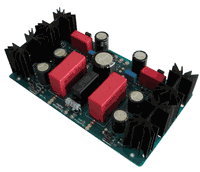GlassWare Audio Design
Thanks for Supporting the Tube CAD JournalNew Balancer PCB and Kit
Headphone Amplifier Kits

Headphones and headphone amplifiers
Ah, headphones: either you love them or you hate them. I love them. I like not hearing noise from refrigerators, air conditioners, barking dogs, the subwoofers of rude neighbors, cars, trucks, and especially loud minibikes and motorcycles. Moreover, I like hearing normally unfamiliar and uncharted musical events: the floorboards creaking beneath the 300-pound jazz bass player, the hall’s reverberation, the guitarist’s fingerprints across the strings, the vocalist’s gasps for air, the recording engineer’s clumsy edits, the sheet music’s repeated turnings during every classical performance, George Harrison’s thick-fingered flubs, the mechanical articulation on a saxophone, the pianist’s humming—well, strike that last one item—in other words, the hundred diminutive sonic artifacts harbored by recordings but seldom heard. Some are annoying, others are embarrassing, others still are transporting, but all reveal a hidden world unmapped by even the finest loudspeakers.
What’s wrong with loudspeakers? A loudspeaker’s crossovers and massive diaphragms smear the sonic minutia, rolling over the barely audible information, washing away the recording’s sonic fingerprints, like a blurry photograph that truthfully reveals a dress’s color, but not its texture. Here is a simple experiment: visit a music store and listen to the sonic signature of each type of cymbal displayed; then go home and listen to your loudspeakers. What happened to that obvious and marked difference in timbre? Now listen to the same recordings with high-quality headphones. Can you hear more of the distinctions in size, brand, and composition of cymbals? (Yes, I know that CDs make this test much harder than LPs or tape did.)
To subtract further, the little that the loudspeaker can faithfully reproduce pours into a sonic coffin known as your listening room. Parallel walls, floor, and ceiling reverberate unevenly, stressing some frequencies, but attenuating others. I imagine that even the air between a loudspeaker and your ears subtracts from what the ear could hear directly against the loudspeaker; being no more than a mixture of gasses, how could we expect it to hold a precise imprint for very long before its natural sponginess smears the finest details? Here is an additional experiment: sit in the front row of a concert hall and listen to the amazing brightness, if not downright harshness of many of the orchestra’s instruments. Then move to the rear of the hall and sit in an untaken seat and listen to the soft, murky sound, where many discrete violins meld into one fat, large violin.
Verily, headphones circumnavigate so many sonic snares that it is amazing that more are not ardent headphone listeners.
Ah, headphones: either you love them or you hate them. I love them. I like not hearing noise from refrigerators, air conditioners, barking dogs, the subwoofers of rude neighbors, cars, trucks, and especially loud minibikes and motorcycles. Moreover, I like hearing normally unfamiliar and uncharted musical events: the floorboards creaking beneath the 300-pound jazz bass player, the hall’s reverberation, the guitarist’s fingerprints across the strings, the vocalist’s gasps for air, the recording engineer’s clumsy edits, the sheet music’s repeated turnings during every classical performance, George Harrison’s thick-fingered flubs, the mechanical articulation on a saxophone, the pianist’s humming—well, strike that last one item—in other words, the hundred diminutive sonic artifacts harbored by recordings but seldom heard. Some are annoying, others are embarrassing, others still are transporting, but all reveal a hidden world unmapped by even the finest loudspeakers.
What’s wrong with loudspeakers? A loudspeaker’s crossovers and massive diaphragms smear the sonic minutia, rolling over the barely audible information, washing away the recording’s sonic fingerprints, like a blurry photograph that truthfully reveals a dress’s color, but not its texture. Here is a simple experiment: visit a music store and listen to the sonic signature of each type of cymbal displayed; then go home and listen to your loudspeakers. What happened to that obvious and marked difference in timbre? Now listen to the same recordings with high-quality headphones. Can you hear more of the distinctions in size, brand, and composition of cymbals? (Yes, I know that CDs make this test much harder than LPs or tape did.)
To subtract further, the little that the loudspeaker can faithfully reproduce pours into a sonic coffin known as your listening room. Parallel walls, floor, and ceiling reverberate unevenly, stressing some frequencies, but attenuating others. I imagine that even the air between a loudspeaker and your ears subtracts from what the ear could hear directly against the loudspeaker; being no more than a mixture of gasses, how could we expect it to hold a precise imprint for very long before its natural sponginess smears the finest details? Here is an additional experiment: sit in the front row of a concert hall and listen to the amazing brightness, if not downright harshness of many of the orchestra’s instruments. Then move to the rear of the hall and sit in an untaken seat and listen to the soft, murky sound, where many discrete violins meld into one fat, large violin.
Verily, headphones circumnavigate so many sonic snares that it is amazing that more are not ardent headphone listeners.


